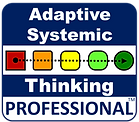
ADAPTIVE SYSTEMIC THINKING (AST)
The Adaptive System Thinking Program™ was developed over a 20 year time span and has proven itself across a wide variety of environments. Based primarily on the thinking processes of the Theory of Constraints the AST™ is a streamlined but extremely effective vehicle to learn a process of strategic thinking that will leave an indelible mark on the way a person looks at problems and solutions within a system.
A cross functional team that goes through this program together grows together. They learn a new way of thinking, communicating and problem solving collectively. They better see connections across the company and begin to break down silo thinking and solution application.
Bring the Adaptive Systemic Thinking (AST)™ program to your team! If you have a team that wants to explore the DDMRP at a deep technical level, we will send one of our endorsed instructors to you. Contact us about options.
DRIVING INNOVATION AND ADAPTATION
Today the very survival of an organization is subject to its ability to drive innovation and adaptation. Innovation and adaptation is driven by identifying and overcoming obstacles and risks to the system's ability to manage, grow and sustain flow, many of which often remain hidden under the surface and obscured from view.




THE POWER OF THE PROCESS
This video is an example a completed presentation from the Adaptive Systemic Thinking Program. Chad Smith, ASTP Master Instructor, walks an audience through a presentation based off of an actual analysis at a large wood products company from the United States.
SCHEDULED ADAPTIVE SYSTEMIC THINKING PROGRAMS (IN-PERSON ONLY)
MORE ABOUT THE PROGRAM AND PROCESS
CAN YOUR ORGANIZATION THINK SYSTEMICALLY?
-
Are people in your organization formally trained to think systemically?
-
Do they have a common systemic language and framework to think and work within?
-
Do people in your organization understand the connections between departments, resources and people?
-
Are people given enough visibility to understand the connections between departments, resources and people?
-
Are people discouraged from thinking and offering solutions outside of their area of responsibility?
-
Do people understand how the different forms of variability affect the enterprise and FLOW through it?
How does your organization score with these questions?

If an organization's people can’t think systemically then that organization is blind to conflicts and distortions to relevant information at the systemic level. That means your organization is INCAPABLE of thinking and adapting for FLOW in the VUCA World. Its ability to continue the progression through the Demand Driven Adaptive Enterprise (DDAE) Model will be compromised.
Through a blend of instructive formats participants learn a repeatable systemic problem-solving process, apply that process to a defined topic within their organization and learn and internalize the building blocks for sensing, adapting and innovating across the supply chain (customers and suppliers) for continual ROI improvement. The ASTP™ is intended for strategic level personnel and/or their direct reports. Examples include organizational, divisional and functional leaders, individuals responsible for implementing and guiding major initiatives, and internal consultants and/or corporate change agents. The seminar can be delivered on an in-house basis to leadership teams. The program can be extremely effective with leadership teams looking to take and keep the company at the high stages of the DDAE Development Path. It can also be extremely effective at introducing a serious trajectory change in any struggling organization.
THE PROBLEM SOLVING PROCESS
Step 1: Find a systemic problem. Learn how to make the connections across organizational symptoms that are potentially separated by function, location, etc and identify a systemic core problem that results in the persistence of those symptoms. Many organizations and managers fight the same fires on a frequent basis, waging the same tired battles over and over again. Intuitively, we know that as long as we continue to observe the same types of symptoms, we are not addressing the real underlying problem. But, how do we find the real problem? In an organization or functional area that continues to struggle with the same types of challenges or symptoms there are often underlying and unresolved dilemmas that tug people in at least two directions at once. These dilemmas often result in a constant and unsatisfactory set of compromises at all levels producing consistently poor or underwhelming results.
Step 2: Spark a breakthrough idea. Identify a specific idea that directly challenges the core problem. A breakthrough idea allows an organization or an individual to break the underlying dilemmas by attacking and invalidating the assumptions that hold them together. This yields a place to start in order to build a future state, one that does not include the current symptoms. It is a solution that is elegant; it is both simple and extremely significant. The simplicity comes from the fact that we are attacking the symptoms at fewer points (through the underlying dilemmas) and the significance is defined by the knowledge of how the symptoms are connected to and dependent upon the dilemmas.
Step 3: Construct a full and immune solution. Construct a complete solution driving to the required results while ensuring there are no disastrous side-effects. A breakthrough idea is just a starting point. Other solution elements must be identified and incorporated to round out the solution and mitigate risks.
Step 4: Plan to address obstacles. Develop an implementation path not based on arbitrary milestones but on the known and significant specific obstacles to be encountered in the environment with regard to the defined solution. This path should be carefully sequenced, identifying immediate primary objectives to achieve.
Step 5: Implement and manage the change. Learn a tool set to use with people to sell, facilitate and adapt your plan through implementation.

ABOUT THE ASTP CERTIFICATION
An individual that successfully demonstrates the ability to communicate their analysis through all stages will be endorsed as an "Adaptive Systemic Thinking Professional". This process is done after the conclusion of the program after the candidate has had the opportunity to properly prepare.

.png)

